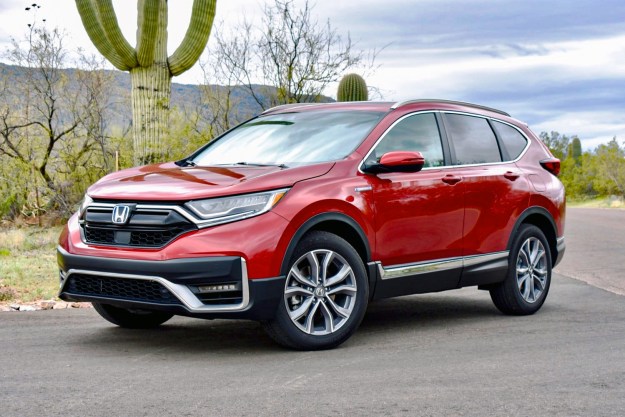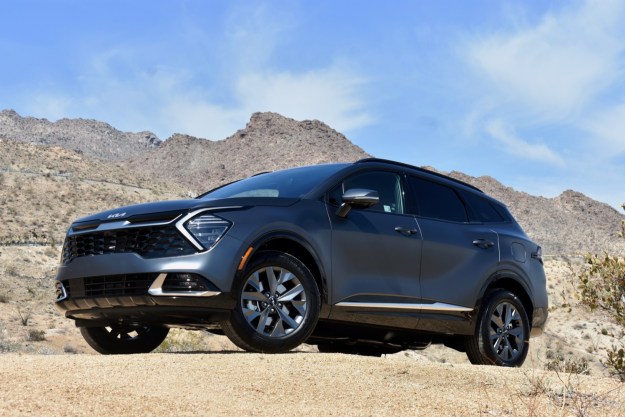
“A solid hybrid powertrain makes Honda's popular CR-V crossover even better.”
- Nice to drive
- Punchy acceleration
- Spacious interior
- Regenerative braking paddle shifters
- Rivals get better gas mileage
- Apple CarPlay and Android Auto aren't standard
Launched in 1997, the Honda CR-V was one of the first crossover utility vehicles. That made Honda a trendsetter in the 1990s. However, the automaker has fallen behind on a different important trend: Hybrid powertrains. The Toyota RAV4 Hybrid is now in its second generation, and Ford brought back the Escape Hybrid for the 2020 model year, while Honda’s option has only just arrived.
The 2020 Honda CR-V Hybrid attempts to make up for lost time. It adapts the two-motor hybrid system previously used in the Accord Hybrid and Insight, marking the first use of this system with all-wheel drive, which is standard on all trim levels.
The base LX model starts at $28,870 – a $2,320 premium over a gasoline CR-V. Our test car was a range-topping Touring model, with a starting price of $37,070, or $1,225 over a gasoline CR-V Touring.
Design and interior
You’ll need a sharp eye to spot the differences between a CR-V Hybrid and a gasoline model. Exterior styling changes are limited to blue badging, a model-specific rear bumper that hides the exhaust, and LED fog lights on higher trim levels.
Automakers generally take one of two approaches to the exterior styling of their crossovers, and the CR-V falls somewhere in the middle. While crossovers are essentially jacked-up cars, there is a temptation to make them look rugged and truck-like, as Toyota did with the RAV4. In contrast, the latest Ford Escape looks more car-like, almost like a Ford Focus as viewed through a funhouse mirror. The CR-V takes cues from both playbooks. Its upright profile and imposing front end are truck-like, but its slim headlights and curved surfaces are more car-like. The result won’t turn heads, but it’s handsome and should age well.

The CR-V Hybrid compares favorably to its rivals on interior space. The Honda has more rear legroom than the Ford Escape Hybrid and Toyota RAV4 Hybrid. The Ford offers more front legroom, and the it and the Honda are virtually tied on headroom.
The Honda also offers more cargo space than the Toyota with its rear seats in place, and the Ford with its rear seats folded (Toyota does not quote an amount with the rear seats folded). The Escape Hybrid has a sliding second-row seat that gives it a space advantage over the CR-V with the rear seats in place (at the expense of second-row legroom, however). The CR-V Hybrid also has less cargo space than a gasoline CR-V, as the battery pack sits under the cargo floor. The Honda does have a low load-floor height, which makes getting things in and out easier.
Tech, infotainment, and driver assist
A 7.0-inch touchscreen with Apple CarPlay and Android Auto is available, but not on the base LX trim level. Touring models get wireless phone charging, but the charging pad is too small for some phones.
A digital instrument cluster includes hybrid-specific displays, such as a power-flow meter that tells you whether the car is using its gasoline engine or electric motor. The graphics for the instrument cluster are high quality and easy to read, something that can’t be said of the cheap-looking graphics on the CR-V’s main touchscreen.

The CR-V Hybrid comes standard with the Honda Sensing suite of driver aids, which includes autonomous emergency braking, forward collision warning, road departure mitigation, lane departure warning, lane keep assist, and adaptive cruise control. The Toyota RAV4 Hybrid has a comparable array of standard driver aids. The Ford Escape Hybrid has standard lane-keep assist and autonomous emergency braking, but adaptive cruise control is an optional extra.
Ford and Toyota don’t have an equivalent to Honda’s road departure mitigation, which automatically steers the car back onto the road if a wheel crosses an outer lane marking. However, the RAV4 Hybrid has standard traffic sign recognition, and the Escape Hybrid has post-collision braking, intended to keep a car from rolling into other objects after a collision.
Driving experience
The CR-V Hybrid’s powertrain consists of a 2.0-liter four-cylinder gasoline engine working with Honda’s two-motor hybrid system. One electric motor powers the wheels, while the other acts as a generator, harvesting energy from regenerative braking and from the gasoline engine. The gas engine only drives the wheels directly when the system deems it most efficient to do so.
Total system output is 212 horsepower and 232 pound-feet of torque. That’s more than a conventional CR-V, or a Ford Escape Hybrid. The RAV4 Hybrid has 219 hp; Toyota doesn’t quote a torque figure.
Because the gasoline engine isn’t coupled to the wheels most of the time, Honda’s system has a quirk. The engine’s RPM doesn’t always match your acceleration or road speed. Honda improved this with the CR-V Hybrid, and we did notice the engine didn’t seem to wail as much at low speeds as in the Honda Insight. The transition between gasoline and electric power still feels more linear in the Escape Hybrid and RAV4 Hybrid, however.
The CR-V Hybrid is just plain nice to drive.
That aside, the CR-V Hybrid felt great to drive. It’s not fast, but the electric motor provides a helpful shove of torque when pulling away from stops. The ride is smoother than the rival CUVs from Ford and Toyota, and the interior is quiet. The paddle shifters that control regenerative braking were a helpful touch. We could slow the car without touching the brake pedal, much like downshifting in a manual-transmission car.
Like the standard CR-V, the hybrid uses a mechanical all-wheel drive system, with a driveshaft linking the front-mounted engine to the rear axle. Ford did the same with the Escape Hybrid, but the Toyota RAV4 Hybrid uses a second electric motor for the rear wheels, with no physical connection to the front wheels. Mechanical all-wheel drive was cheaper, Honda told Digital Trends, and it’s unlikely most drivers will notice the difference in normal conditions. But what about abnormal conditions?

Honda and Toyota boast that their hybrid crossovers can handle some off-roading, and claim their respective all-wheel drive systems are key to that. At the CR-V Hybrid launch, Honda let us drive around a sand pit in both the CR-V and a RAV4 Hybrid. Sure enough, the CR-V did better. The RAV4 Hybrid lurched awkwardly along the course as its electronics clicked and whirred in protest. The CR-V Hybrid also has more ground clearance and better approach and departure angles than the RAV4 Hybrid, so it’s less likely to smash into obstacles.
We didn’t have an opportunity to test the CR-V Hybrid on a more traditional off-road trail, as we did with the RAV4 at its launch, though. Of course, neither can match the capability of true off-roaders like the Jeep Wrangler and Toyota 4Runner. Crossovers like the CR-V and RAV4 aren’t designed for serious off-roading. But if you ever find yourself on the run from Tusken Raiders, the CR-V Hybrid will have your back.
Gas mileage and safety
The real reason to buy a hybrid is gas mileage, and in this area the CR-V falls short of its competitors. The Honda is rated at 38 mpg combined (35 mpg city, 40 mpg highway), while the RAV4 Hybrid is rated at 40 mpg combined (41 mpg city, 38 mpg highway). The CR-V does beat the all-wheel drive Escape Hybrid’s highway rating of 37 mpg, but the Ford is also available with front-wheel drive that helps it achieve 41 mpg combined.
We managed to better the Honda’s Environmental Protection Agency ratings, achieving 51 mpg on a short drive loop. However, the numbers tumbled quickly with less miserly driving.
The CR-V Hybrid falls short of its competitors on gas mileage.
The CR-V Hybrid received a five-star overall rating from the National Highway Traffic Safety Administration (NHTSA). The hybrid model also comes standard with the headlights needed to achieve a Top Safety Pick rating from the Insurance Institute for Highway Safety (IIHS).
Honda offers a three-year, 36,000-mile basic warranty and five-year, 60,000-mile powertrain warranty. That’s the same coverage as Ford and Toyota. Honda has a solid reliability record. While the hybrid powertrain is new, the CR-V itself has proven rock solid.
How DT would configure this car
Honda made this easy by making many key features standard equipment. All trim levels have standard all-wheel drive and the Honda Sensing suite of driver aids. The only thing missing is Apple CarPlay/Android Auto compatibility, which requires upgrading from the base LX trim level to the EX. There isn’t much benefit to upgrading further. The EX-L adds leather seats, and the Touring gets wireless phone charging, a hands-free power tailgate, and heating steering wheel, but these are luxuries, not necessities.
Our Take
That the 2020 Honda CR-V Hybrid is a well-executed example of the breed isn’t surprising. The standard CR-V was already one of the best small crossovers, and Honda’s hybrid system has been proven in the Accord Hybrid and Insight. But the CR-V Hybrid isn’t just good in isolation — it also stacks up well against its two rivals.
Honda wasn’t able to beat the Toyota RAV4 Hybrid and Ford Escape Hybrid on fuel economy, but the CR-V Hybrid makes up for that in other areas, and the efficiency gap is small. The Honda is nicer to drive than its rivals, has more usable cargo space, and offers plenty of standard driver aids.
Should You Get One?
Yes. Sometimes it’s good to be fashionably late.
Editors' Recommendations
- Mercedes-AMG EQE SUV first drive review: a better electric SUV
- Mercedes-Benz EQE SUV first drive review: ’90s look, cutting-edge tech
- 2023 Kia Niro EV first drive review: Practical doesn’t have to bore you to tears
- 2022 Mercedes-Benz EQB first drive review: An EV better than its gas sibling
- 2022 Rivian R1S first drive review: An EV SUV fit for an expedition or a drag race


